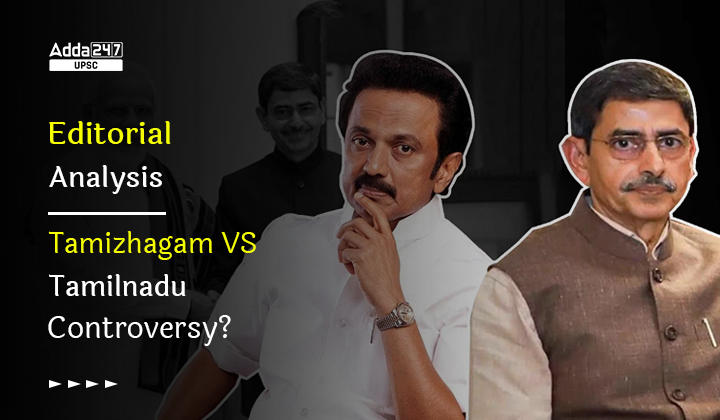Table of Contents
Tamizhagam VS Tamilnadu Controversy:
Tamizhagam: Tamizhagam means home of Tamil or geographical region where ancient Tamil people live.
Tamilnadu: In translation, the word ‘Tamilnadu’ can also be read as “country” or “Tamil Land”
Context
- While addressing a program felicitating organisers and volunteers of the Kashi Tamil Sangamam, held at the Raj Bhavan in Chennai on January 4, Tamilnadu’s governor Sri R.N. Ravi said that the word ‘Tamizhagam’ was a more appropriate term instead of Tamil Nadu.
- Parties opposing the ‘Tamizhagam’ remark are demanding that the Centre remove Ravi as Tamil Nadu governor.
In What Context Did Governor Ravi Suggest Tamizhgam?
- Governor Ravi argued that the word ‘Nadu’ in the Tamil language means ‘land’, but has come to mean ‘country’ at times, viewed through the lens of Tamil nationalism.
- He also said, “There has been regressive politics with the wrong habit of refusing everything that benefits all sections of people including academicians blindly for their own interests, claiming that the state is not integrally part of India,”
- The Governor also said that for over 50 years, efforts had been made to reinforce the narrative that Tamil Nadu is not an integral part of India.
- He said, “Tamil Nadu is soul, an idea and an identity of Nation and we should keep it alive to erase some falsehood and fiction of negative approach prevailing in the state.”
- So, Governor Ravi seems to have suggested the word ‘Thamizhagam’ instead of ‘Tamil Nadu’ to distance from the interpretation of the term ‘Tamil Nadu’ as more of an autonomous region, than one that is part of India.
What Is The Significance Of Thiruvaiyaru Thyagaraja Aradhana Mahotsava?
What Is ‘Tamizhagam’?
- Tamizhagam literally translated means home of Tamil.
- The word is also spelled as Tamilakam. It also refers to a geographical region where ancient Tamil people live.
- The ancient Tamilakam is made up of today’s land of Tamil Nadu, Kerala, Lakshadweep, Puducherry and southern areas of Andhra Pradesh and Karnataka.
What is Chennai’s Margazhi Festival? | A Season of Music & Dance
Why is there an issue with Tamil Nadu?
The issue arises from the meaning lost in translation, specifically referring to the word ‘Nadu’ in Tamil Nadu. In translation, the word can also be read as “country”. The state’s current name literally means “Tamil Land”.
Soorasamharam 2022: The Kanda Sashti festival!
Brief History Of The Demand For Separate Dravidnadu
- The South Indian Liberal Federation, popularly known as Justice Party, which was founded in 1917 by Sir Pitti Theagaraya Chetty, Dr T M Nair, and Dr C Natesa Mudaliar, was the first to raise the flag of anti-Brahminism, and oppose the caste system that put Brahmins at the top of the social hierarchy.
- At the time, the presence of Brahmins in the Madras government was disproportionately higher than their population in the state, and the Justice Party demanded opportunities for those lower in the caste hierarchy.
- Later, Periyar, the founder of the Self-Respect Movement (1925)also emphasised the distinct cultural identity of the Tamil nation.
- In 1938, the Justice Party and Self-Respect Movement came together, representing the merger of the party and the movement.
- In 1944, the new outfit was named Dravidar Kazhagam and launched a movement for an independent Dravida nation.
- Post-independence, DK continued to demand Dravida Nadu. In 1949, Annadurai split from Periyar due to ideological differences, and his DMK joined the electoral process.
- The DMK’s platforms were social democracy and Tamil cultural nationalism, but Annadurai was silent on Dravida Nadu. In 1967, Annadurai became Chief Minister.
Conclusion
It is without any doubt that the DMK’s ideological parent party (Dravidar Kazhagam or DK founded by social reformer Periyar) wanting a separate Dravida Nadu, later a separate Tamil Nadu however, since the time immemorial, Tamil Nadu is not just an integral part of India but the very soul of this great nation.



 TSPSC Group 1 Question Paper 2024, Downl...
TSPSC Group 1 Question Paper 2024, Downl...
 TSPSC Group 1 Answer key 2024 Out, Downl...
TSPSC Group 1 Answer key 2024 Out, Downl...
 UPSC Prelims 2024 Question Paper, Downlo...
UPSC Prelims 2024 Question Paper, Downlo...




